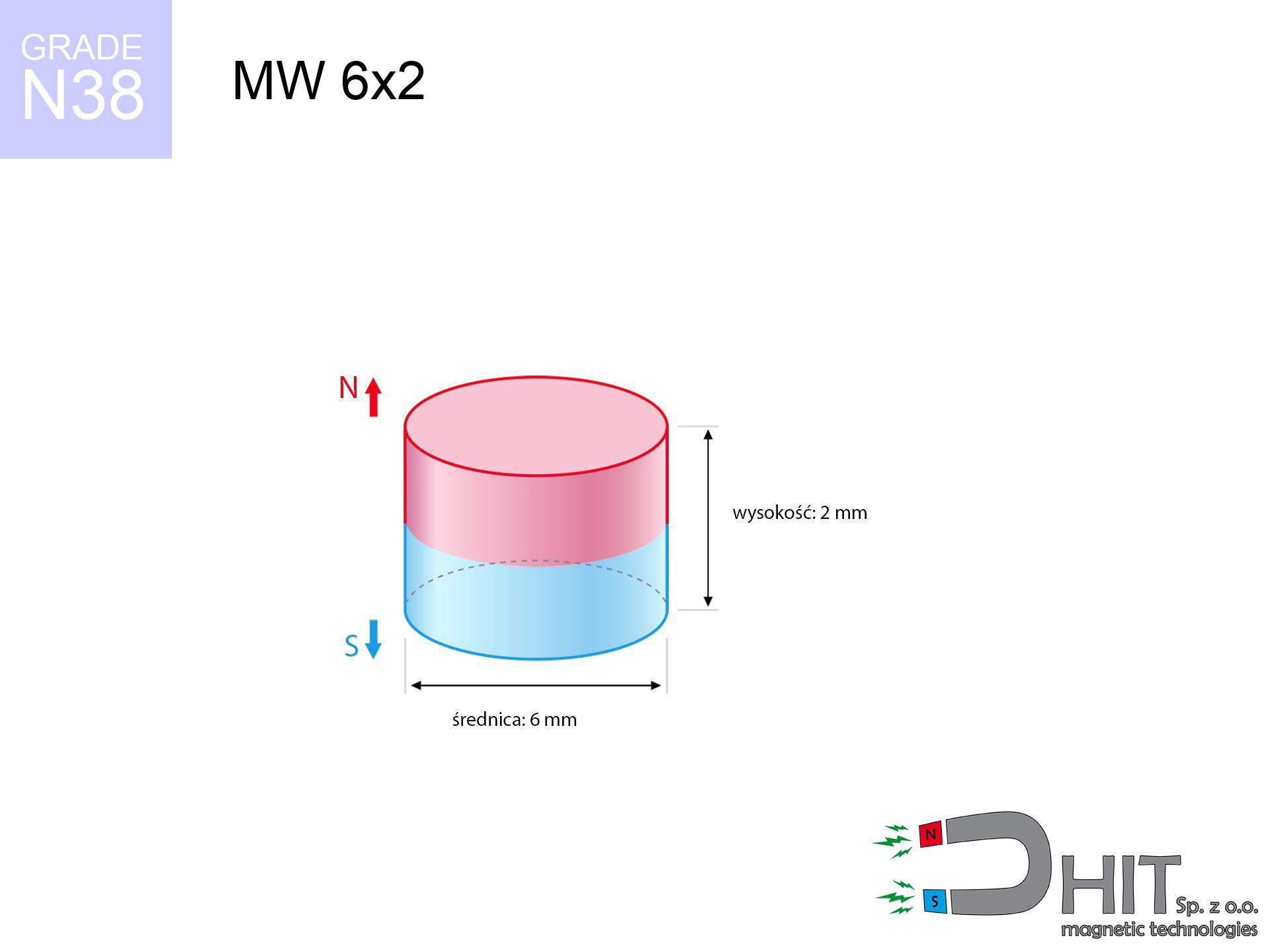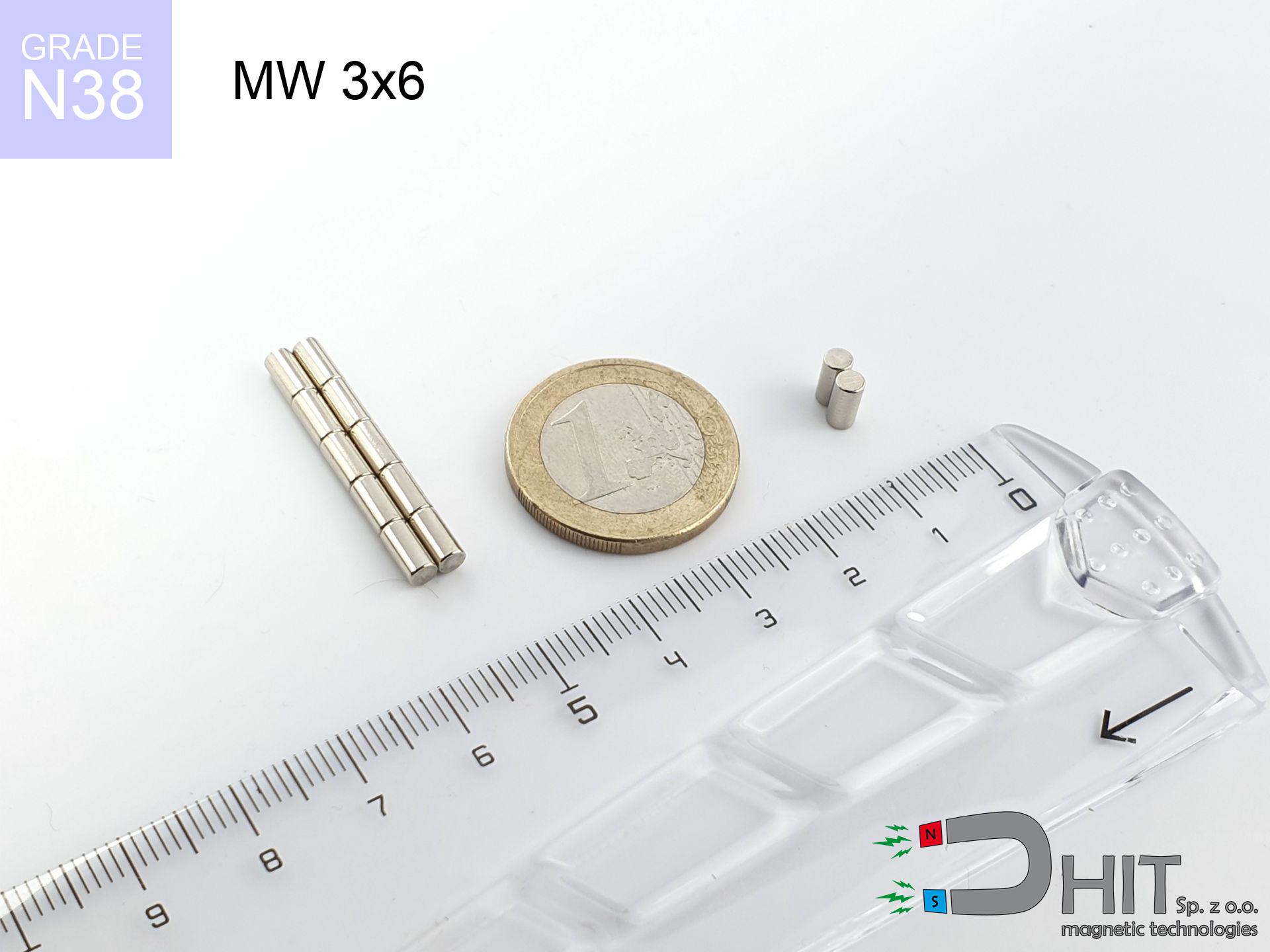MW 6x2 / N38 - cylindrical magnet
cylindrical magnet
Catalog no 010092
GTIN: 5906301810919
Diameter Ø [±0,1 mm]
6 mm
Height [±0,1 mm]
2 mm
Weight
0.42 g
Magnetization Direction
↑ axial
Load capacity
0.66 kg / 6.47 N
Magnetic Induction
343.37 mT
Coating
[NiCuNi] nickel
0.21 ZŁ net + 23% VAT / pcs
Want to negotiate the price?
Call us +48 22 499 98 98 or write via form on the contact page. Test the magnet's power with our power calculator.
Orders placed by 14:00 are shipped the same day.
MW 6x2 / N38 - cylindrical magnet
Magnetic properties of material N38
Physical properties of NdFeB
Shopping tips
Moreover, even though neodymium is part of the strongest magnets, they are susceptible to corrosion in humid environments. Therefore, they are coated with a coating of silver to increase their durability. It's worth noting that NdFeB neodymium magnets are about 13% lighter than SmCo magnets and, despite their power, are brittle, which requires special caution during their handling. For this reason, any mechanical processing should be done before they are magnetized.
In terms of safety, there are several recommendations regarding the use of these magnets. They should not be used in acidic, basic, organic environments or in solvents, and also in water or oil. Additionally, they can distort data on magnetic cards and hard drives, although data deletion using a neodymium magnet is not always certain.
In terms of properties in different environments, neodymium magnets are sensitive to corrosion, especially in humid conditions. Therefore, they are often covered with thin coatings, such as epoxy, to protect them from external factors and extend their lifespan. Temperatures exceeding 130°C can result in a reduction of their magnetic properties, although there are particular types of neodymium magnets that can tolerate temperatures up to 230°C.
As for potential dangers, it is important to avoid using neodymium magnets in acidic environments, basic conditions, organic or solvent environments, unless they are properly protected. Additionally, their use is not recommended in water, oil, or in an atmosphere containing hydrogen, as they may lose their magnetic strength.
Advantages and disadvantages of neodymium magnets
Neodymium magnets, also known as NdFeB magnets, are currently the strongest permanent magnets available on the market. Their exceptional magnetic properties make them suitable for various industries, technologies, and everyday life. Below are the key advantages:
- Immense attractive force: Even small neodymium magnets generate a very strong magnetic field.
- High coercivity: They are resistant to demagnetization by external magnetic fields.
- Wide operating temperature range: Standard neodymium magnets operate up to 80°C, with special versions up to 230°C.
- Variety of shapes and sizes: Available in many forms, making them easy to adapt to specific applications.
- Relatively low price compared to strength: They offer the best strength-to-price ratio among all magnets.
- Longevity: With proper use, they retain their magnetic properties for many years.
- Versatility of applications: From electric motors to speakers, separators, toys, and jewelry.
Despite numerous advantages, neodymium magnets also have certain disadvantages to consider:
- Brittleness: They are hard but brittle and prone to cracking or chipping upon impact.
- Limited operating temperature for standard versions: Above the Curie temperature, they lose their magnetic properties.
- Strong magnetic field can be dangerous: They can damage electronics, magnetic cards, and pose a risk of attracting metal objects with great force.
- Difficulties in mechanical processing: Due to their hardness and brittleness, processing them is complex.
Precautions
Neodymium magnets are the strongest magnets ever created, and their strength can shock you.
Familiarize yourself with our information to correctly handle these magnets and avoid significant swellings to your body and prevent damage to the magnets.
Do not place neodymium magnets near a computer HDD, TV, and wallet.
Neodymium magnets produce strong magnetic fields that can damage magnetic media such as floppy disks, video tapes, HDDs, credit cards, magnetic ID cards, cassette tapes, or other devices. They can also destroy videos, televisions, CRT computer monitors. Do not forget to keep neodymium magnets at a safe distance from these electronic devices.
Magnets made of neodymium are incredibly fragile, they easily crack as well as can crumble.
In the event of a collision between two neodymium magnets, it can result in them getting chipped. They are coated with a shiny nickel plating similar to steel, but they are not as hard. At the moment of connection between the magnets, small sharp metal pieces can be propelled in various directions at high speed. Eye protection is recommended.
Magnets will attract to each other, so remember not to allow them to pinch together without control or place your fingers in their path.
In the case of placing a finger in the path of a neodymium magnet, in such a case, a cut or even a fracture may occur.
Magnets should not be treated as toys. Therefore, it is not recommended for youngest children to have access to them.
Neodymium magnets are not toys. You cannot allow them to become toys for children. In the case of small magnets, they can be swallowed and cause choking. In such cases, the only solution is to undergo surgery to remove the magnets, and otherwise, it can even lead to death.
Neodymium magnets should not be near people with pacemakers.
Neodymium magnets generate very strong magnetic fields that can interfere with the operation of a pacemaker. This happens because such devices have a function to deactivate them in a magnetic field.
The magnet is coated with nickel - be careful if you have an allergy.
Studies clearly indicate a small percentage of people who suffer from metal allergies such as nickel. An allergic reaction often manifests as skin redness and rash. If you have a nickel allergy, you can try wearing gloves or simply avoid direct contact with nickel-plated neodymium magnets.
Dust and powder from neodymium magnets are flammable.
Do not attempt to drill into neodymium magnets. Mechanical processing is also not recommended. Once crushed into fine powder or dust, this material becomes highly flammable.
Never bring neodymium magnets close to a phone and GPS.
Intense magnetic fields generated by neodymium magnets interfere with compasses and magnetometers used in navigation, as well as internal compasses of smartphones and GPS devices.
Neodymium magnets can demagnetize at high temperatures.
Whilst Neodymium magnets can lose their magnetic properties at high temperatures, it's important to note that the extent of this effect can vary based on factors such as the magnet's material, shape, and intended application.
To raise awareness of why neodymium magnets are so dangerous, read the article titled How dangerous are powerful neodymium magnets?.





![SM 32x175 [2xM8] / N52 - magnetic separator SM 32x175 [2xM8] / N52 - magnetic separator](https://cdn3.dhit.pl/graphics/products/sm-32x175-2xm8-cep.jpg)



